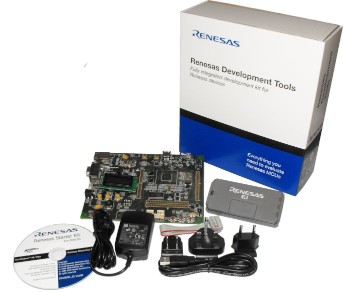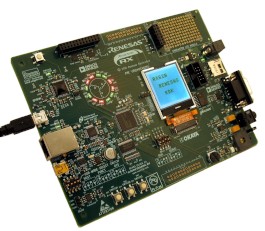|
|||||||||||||||
Renesas RX62N Demo using the IAR Embedded Workbench
|
|||||||||||||||
| Build configuration | Description |
| Blinky | This is a very simple example that just creates two tasks. The tasks communicate via a queue, with an LED being toggled each time a correct and expected value is received from the queue. The Blinky build configuration uses main-blinky.c, the other two build configurations use main-full.c. |
| Debug | This is a more comprehensive demo that creates nearly 50 demo tasks. Two further tasks are then repeatedly creates and deleted as the application runs. The tasks consist mainly of the standard demo tasks - which don't perform any particular functionality other than testing the port (including interrupt nesting) and demonstrating how the FreeRTOS API is used. Information on additional tasks that are created is provided immediately below this table. |
| Debug_with_optimisation | This is very similar to the 'Debug' configuration, but includes an additional high frequency timer test. It also tests that the tasks and tests execute correctly when the optimiser is switched on. |
The Debug and Debug_with_optimisation build configurations create the following tasks and tests in addition to the standard demo tasks:
- Check task
This only executes every five seconds but has the highest priority to ensure it gets CPU time. Its main function is to check that all the standard demo tasks are still operational. The check function writes to a status string that can be viewed at the very bottom of the "Task Stats" page served by the integrated web server. It also toggles LED5 if using the RSK, or LED9 if using the RDK. If the LED controlled by the check task is toggling once every five seconds then all the tasks are executing without any errors having been reported. If the toggle frequency increases to once every 200ms then an error has been detected in at least one task.
Some of the tasks check to ensure their own execution timing remains within fixed limits, and with nearly 50 tasks executing these limits can sometimes be breached causing an error to be reported where none really exists. The timing constraints can be put under even more stress when the 20KHz interrupt is running too. Therefore an error being reported is not necessarily indicative of an error in the FreeRTOS port, but just a symptom of a task not getting the CPU time it requires to remain within its tight (self imposed) timing constraints.
- uIP task
This is the task that runs the uIP TCP/IP stack. All network related processing is performed in this task, making the TCP/IP Flash and RAM footprint extremely small compared to other embedded TCP/IP implementations.
- Reg test tasks
These two tasks fill the microcontroller registers with known values before checking that each register still contains the written value. The two tasks each use different known values. The tasks execute with a very low priority so will get preempted often. If a register ever contains an unexpected value then an error has occurred - probably in the context switching or interrupt mechanism. The reg test tasks write directly into registers and are therefore written in assembly code.
- High frequency timer test
This test configures a timer to generate an interrupt at 20KHz. The interrupt priority is above configMAX_SYSCALL_INTERRUPT_PRIORITY so its timing should not be effected by the RTOS kernel. The jitter in the interrupt timing is measured and displayed at the bottom of the "Run Time Stats" page served by the integrated web server.
Web server configuration
The IP address used by the RX62N board is set by the constants configIP_ADDR0 to configIP_ADDR3. These are specified at the bottom of the FreeRTOSConfig.h header file that is located in the chosen project directory. Constants that define the MAC address and the NET mask are located in the same place of the same file.The IP addresses used by the web browser and the RX62N development board must be compatible. This can be ensured by making the first three octets of both IP addresses the same. For example, if the web browser computer uses IP address 192.168.0.1, then the RX62N development board can be given any address in the range 192.168.0.2 to 192.168.0.254 (other than any addresses that already exist on the same network).
The MAC address assigned to the RX62N must be unique on the network to which it is being attached.
Building and executing the demo application
- Connect the chosen development board to a computer running a web browser either directly using a point to point (crossover) cable, or using a standard Ethernet cable through a hub or switch (only point to point has been tested, but both should work).
- If using an RSK development board connect the RSK to the host computer using an E1 JTAG interface (provided as part of the RSK) then apply power. If using an RDK development board just connect the micro USB socket on the RDK that is marked J-Link to the host computer - no separate power is needed.
- Open the RTOSDemo.eww workspace from within the Embedded Workbench IDE.
- Select "Build All" from the Embedded Workbench "Project" menu - the demo application should build without errors.
- When the build completes click "Download and Debug" from the Embedded Workbench "Project" menu (or press CTRL+D) to program the microcontroller flash memory and start a debug session.
The demo application should behave as follows (LED numbers are correct for the RSK, numbers in brackets are correct for the RDK):
- LEDs LED0, LED1 and LED2 (4, 5 and 6 on the RDK) are controlled by the standard 'flash' tasks. Each will toggle at a fixed but different frequency.
- LED5 (9 on the RDK) is controlled by the 'check' task and will toggle every 5 seconds if no errors have been detected.
- LED3 and LED4 (11, 12, 13 and 14 on the RDK) can be turned on and off interactively using the IO page served by the integrated web server.
- The integrated web server will serve the web pages described below to a standard web browser. To connect to the target:
- Open a web browser on the connected computer.
- Type "HTTP://" followed by the target IP address into the browsers address bar.

Entering the IP address into the web browser
(obviously use the correct IP address for your system)
Served web Pages
The top of each served page includes a menu with links to every other page.
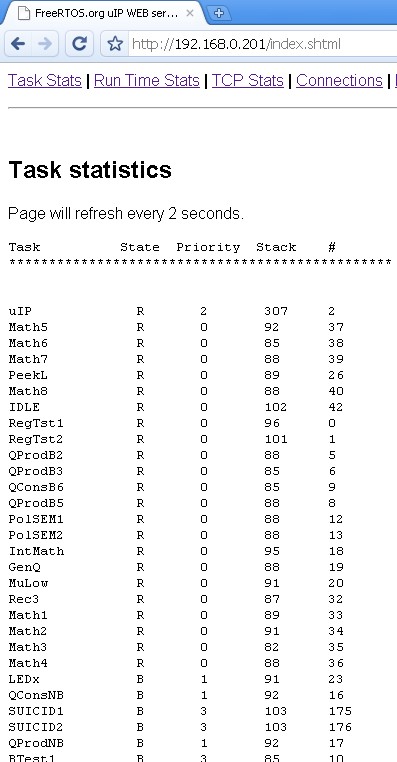
The RTOS stats page served by the RX62N web server
showing status information on each task in the system.
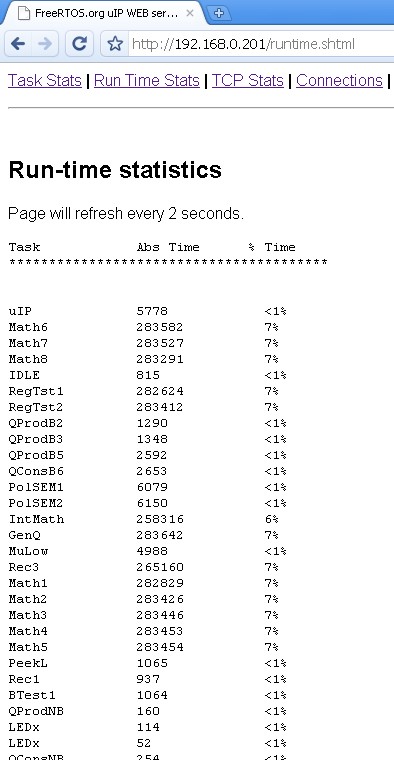
The run time stats page served by the RX62N web
server showing the processor utilisation of each task.
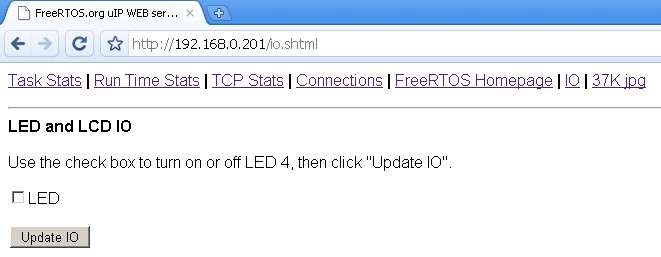
The served IO page
The IO page provides a simple interface to permit various LEDs to be turned on and off from a web browser. The LED number will be correct for the RSK only. Changes are sent to the target board whenever the "Update IO" button is clicked.
Other served pages include TCP/IP statistics and a large JPG image. All the web pages are included in the downloaded binary image - which can make the binary image appear to be quite large (the jpg file by itself is in excess of 36K).
RTOS Configuration and Usage Details
RX62N RTOS port specific configuration
Configuration items specific to this demo are contained in FreeRTOS/Demo/RX600_RX62N-RSK_IAR/FreeRTOSConfig.h or FreeRTOS/Demo/RX600_RX62N-RDK_IAR/FreeRTOSConfig.h for the RSK and RDK hardware respectively. The constants defined in these file can be edited to suit your application. In particular -- configTICK_RATE_HZ
This sets the frequency of the RTOS tick. The supplied value of 1KHz is useful for testing the RTOS kernel functionality but is faster than most applications need. Lowering this frequency will improve efficiency.
- configKERNEL_INTERRUPT_PRIORITY
This defines the interrupt priority used by the RTOS kernel for the timer and software interrupts. This should always be set to the lowest interrupt priority, which is 1 for the RX62N. See the configuration pages for more information.
- configMAX_SYSCALL_INTERRUPT_PRIORITY
This defines the maximum interrupt priority from which FreeRTOS API functions can be called. Interrupts at or below this priority can call FreeRTOS API functions provided that the API function ends in 'FromISR'. Interrupts above this priority cannot call any FreeRTOS API functions but will not be effected by anything the RTOS kernel is doing. This makes them suitable for functionality that requires very high temporal accuracy (motor control for example). The high frequency timer test included in the demo application uses a priority that is above configMAX_SYSCALL_INTERRUPT_PRIORITY. See the configuration pages for more information.
Writing interrupt service routines (ISRs)
Interrupts can be written using the standard IAR compiler syntax. For example, the demo application defines the high frequency timer using:
#pragma vector = VECT_CMT2_CMI2
__interrupt void vTimer2IntHandler( void )
{
/* ISR implementation goes here. This is the highest priority interrupt in
the demo so interrupts are just left disabled while the function executes. */
}
Often an ISR wants to cause a context switch so the task that is returned to when the ISR completes is different to the task that the ISR originally interrupted. This would be the case if the ISR caused a task to unblock, and the unblocked task had a priority above that of the task that was already in the Running state. This can be achieved by calling portYIELD_FROM_ISR(), which takes a single parameter. The parameter must be 0 if a context switch is not required, or non-zero if a context switch is required. This is demonstrated in the code below - which is a handler for a cascaded 8 bit timer 0 and timer 1 compare match interrupt.
#pragma vector = VECT_TMR0_CMIA0
__interrupt void vT0_1_InterruptHandler( void )
{
long lHigherPriorityTaskWoken;
/* Enable interrupts to allow interrupt nesting. */
__enable_interrupt();
/* xFirstTimerHandler() returns true or false, depending on whether the
function unblocked a task that has equal or higher priority than the task
that is already in the running state. */
lHigherPriorityTaskWoken = xFirstTimerHandler();
portYIELD_FROM_ISR( lHigherPriorityTaskWoken );
}
Resources used by FreeRTOS
FreeRTOS requires exclusive use of the software interrupt. FreeRTOS also requires exclusive use of a timer that can generate a periodic tick interrupt - but it is up to the application writer to define which timer is used. To do this the application must define a function called vApplicationSetupTimerInterrupt() that configures the tick interrupt using the chosen peripheral, then define configTICK_VECTOR to inform the RTOS kernel of the interrupt vector number of the chosen timer.It is suggested that a compare match timer is used to generate the tick interrupt, and an example implementation of vApplicationSetupTimerInterrupt() that uses compare match timer 0 is included in both main-full.c and main-blinky.c within the demo application. The demo application defines configTICK_VECTOR within FreeRTOSConfig.h to be 28 (VECT_CMT0_CMI0 - the compare match 0 interrupt vector number). It is suggested that the provided example implementations are used in most cases.
Switching between the pre-emptive and co-operative RTOS kernels
Set the definition configUSE_PREEMPTION within RTOSDemo/FreeRTOSConfig.h to 1 to use pre-emption or 0 to use co-operative. The full demo application may not execute correctly when the co-operative RTOS scheduler is selected.Compiler options
As with all the ports, it is essential that the correct compiler options are used. The best way to ensure this is to base your application on the provided demo application files.Memory allocation
Source/Portable/MemMang/heap_2.c is included in the RX62N demo application project to provide the memory allocation required by the RTOS kernel. Please refer to the Memory Management section of the API documentation for full information.Miscellaneous
Note that vPortEndScheduler() has not been implemented.
NXP tweet showing LPC5500 (ARMv8-M Cortex-M33) running FreeRTOS.
Meet Richard Barry and learn about running FreeRTOS on RISC-V at FOSDEM 2019
Version 10.1.1 of the FreeRTOS kernel is available for immediate download. MIT licensed.
View a recording of the "OTA Update Security and Reliability" webinar, presented by TI and AWS.
FreeRTOS and other embedded software careers at AWS.












